Attack of the 50 foot demon
Balloon art – Japanese style
Writeup and photos by Larry Moss
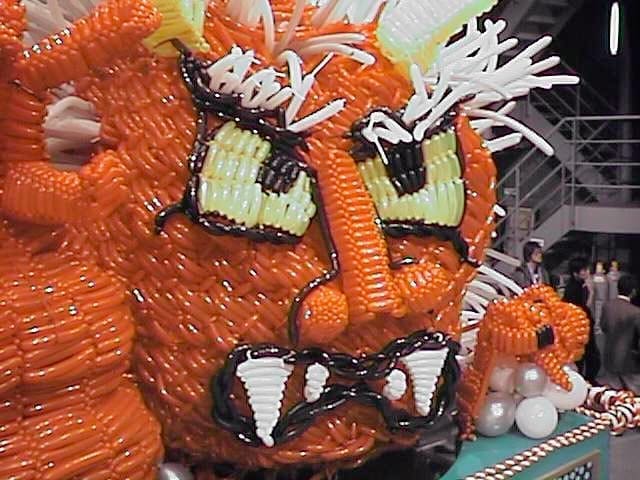
Overview
During the first week of December, 1998, I found myself in Tokyo, Japan
leading a rather unusual, and rather challenging project. I spent
a week training a team of Japanese celebrities and a crew
from Fuji Television in balloon art. The goal was to have the celebrities
build a giant balloon creation as part of a show that was to air on New
Year’s Day.
From the time I got the job until the time I arrived in Tokyo, I was both
excited and scared. This was a chance to do a record breaking sculpture.
I knew that I had all of the technical knowledge to pull it off. There was
nothing I planned to do that I hadn’t done dozens of times before on a
smaller scale, and I had designed it all before leaving for Japan. What I
didn’t know was Japanese, and I needed to transfer the knowledge I had into
the heads of a crew that I was about to meet. All of this was to happen
through a translator.
So, here’s the scoop on the project. I was hired as an instructor to teach
the 8 Japanese celebrities (comedians, actors, and a model) how to do
balloon art. In some respects this was the Japanese equivalent of the
American Circus of the Stars. Celebrities learn skills that they
wouldn’t otherwise use and compete against each other. This particular
group was learning balloon art and had to put their work on display.
Rather than just letting us start with the simple stuff, I had to teach
them how to do a really large creation. The object to be constructed was a
nebuta – a samurai warrior fighting a demon. It measured 8 meters wide,
4.5 meters tall, and 4 meters deep. To take it even further, it was
decided that there should be motion in all of this. I designed it so that
the Samurai’s arm would move, and he would chop the head off of the demon
with his sword. In theory this isn’t difficult. I’ve made other big things
that move. It’s just time consuming. Actually making it happen with 8
celebrities that can only schedule 2 hours at a time for training and that
have never touched twisty balloons is another issue entirely.
To make this a little more doable, it was decided that they would provide
me with seven staff members that would actually do the work. These were
people that could devote the entire week, day and night if necessary, to
this project. The camera was just being used to capture the celebrities
working one-on-one with me. The Japanese speaking staff was to work off
camera with the celebrities to walk them through the things I had taught
them. The staff was to be in the background, even though they were doing
the bulk of the work. Once the project got going, the stars were very
cooperative and put in far more effort than I expected, although a few were
more interested in playing with the camera and
making themselves look funny, leaving the rest of us with even more to do.
The staff they gave me to work with was truly an incredible bunch. It took
them as long to get up to speed as I had predicted, but the patience and
determiantion of all of them is to be commended. They put in 10-12 hour
days without complaining. They took instruction and criticism really well.
Unfortunately, they wanted to only follow my instructions exactly for a
while. Convincing them to take liberties on their own was quite hard. I
did map out everything and tell them exactly what I wanted, but I needed
them to experiment a bit so they understood the way the balloons behave.
After two very long days, I could see it click, and I could actually see this
coming together.
The stars themselves were an interesting group. Even though I don’t know
the language, we all communicated fairly well. We successfully made each
other laugh. I did have one big problem and that’s that I always wanted to
respond to things being said and done, but I was dependent on an
interpretter to make sure my lines come out right. I could always tell
when the translation was successful since the room bursted into laughter.
On the other hand, I often wondered if Kiyomi was really saying to them the
same thing I said to her. If you’ve never worked with an interpretter, you can’t quite imagine what it can
be like.
In the end, the stars successfully built a sculpture, using approximately
15,000 twisty balloons (260’s), of a traditional nebuta. I was as
impressed as they were tired. It felt good to have pulled it off. I
wanted them to do it since teaching them was what I was hired to do, but I
really had expected that the staff would have to do most of it. Without
the staff, it wouldn’t have come together, but the celebrities really did
have their hands in it every bit of the way and did deserve the recognition
they got on TV for their efforts. Being someone that always wants to give
proper credit, I wish the staff was recognized equally for the project. At
least I still get to talk about them here.
My role was teacher, designer, project leader and chief worrier. I helped
with a few especially challenging parts of the sculpture, but in most
cases, I coached and solved problems rather than twist balloons. There was
very little time for me to actually do any of the construction since I was
pulled in every direction constantly. As chief worrier, I made sure to
keep an eye on everything and refused to disappear for rest. The final
construction was done over a 36 hour period, of which I attempted to sleep for two. Most people at least
took a four hour break. I just feared that without me, a problem would
come up that would hold up the whole thing. A problem did come up while I
was gone, but rather than let it stop them, they continued, leaving me with
two hours of work to repair what otherwise would have taken 10 minutes. I
can’t complain too much. The staff really thought they were helping.
(Truth be told there was one problem that came
up while I was there that I couldn’t solve to my satisfaction.)
There was a very minimalist frame that was built since this sculpture
needed to be strong enough to move outdoors, but except for the arm of the
samurai, the frame had essentially no load on it, so this is as pure as you
can get in terms of “balloon” art (in my opinion). The frame was nothing
more than a “T” inside of both the samurai and demon and, as I said, was
used as additional support so that we didn’t have any unexpected surprises
when we moved it after a 36 hour construction period. Most of the
sculpture was actually built and assembled off of the frame so I know it
could support itself.
Some information about the construction techniques used here can be found
in the balloon fabric guide.
As this was being designed, the
official nebuta web site was referenced.
The list of Fuji TV staff members that helped on this
project.
The end result of this whole thing was a few minutes on Japanese
television. Thanks to Fuji Television, a couple of
video clips are available for
viewing.
A little more detail
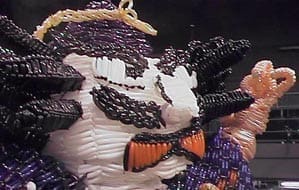 |
| The samurai face was the key element of the entire project. |
Samurai
The face of the samurai posed a serious challenge for a number of reasons.
Not the least of which were creative differences between myself and the
director of the show. That, followed with the fact that an American like
myself, obviously didn’t quite understand some of the things that were
important on a sculpture of this sort to the Japanese folks I was working
with.
What we were faced with was me trying to design something I didn’t
understand, and a bunch of informed Japanese trying to change the design in
ways that weren’t possible. We eventually managed to reach a compromise and
it all came together quite satisfactorily.
As you can see from the image, a serious effort was made to capture the
fierceness of a samurai warrior. We spent quite a lot of time
experimenting with facial expressions. Several attempts at facial features
were tossed aside until we found something everyone was happy with.
The director was being quite picky about the face, so making plans for
that, he asked that the crew work on the face during the training and
practice sessions in order to get a preview that he could think about for a
while. It ended up being changed far more than expected before it was
over. In fact, the original face was
even a different color. When we started out we were very concerned about
the color matching a skin tone as closely as possible. Later, it was
decided to switch to the kabuki look (white face) seen on this page.
While the dimensions of the sculpture were mentioned above, the numbers
seem to have very little impact on most people. In fact, to be honest,
even as the designer of the figures, despite the fact that I was the one
that did all of the calculations for balloon usage, the shear size of it
was still rather overwhelming. As it started to take shape, I looked for
ways to demonstrate it’s hugeness. I think this picture of the samurai’s hand does a good job.
I mentioned above the difficulty I had in understanding Japanese art. I
reviewed books and web sites with images of samurais as well as other
scenes to get a taste of what the staff would be looking for. The
production company also provided me with a number of drawings and photos of
what they wanted to see in this sculpture. After all of that, I envisioned
a samurai in armor to match the fierce facial expressions they had asked
for. Instead, what they wanted was a more gentle look in clothing; a
nicely patterned kimono.
Kimono aside, this was a warrior, and he needed the ability to fight his
mortal enemy. Therefore, a weapon was needed. All of the photos and
drawings I had seen pictured a Samurai holding a spear or a sword. I
chose a sword since the original plan was to show motion in the final
sculpture. By using a sword, the samurai could actually slice the head off
the demon. That final special effect ended up not happening, but we stuck
with the sword anyway.
Assembling the pieces of the sculpture was quite a chore. The head,
which was the first piece made in the practice sessions,
was the
very last thing to be placed in the entire construction. Positioning was
therefore a challenge. I wanted nothing more than to see it in place as
soon as possible. The director wanted to create a sense of accomplishment
by ending with the single most important piece of the structure with all of
the TV cameras rolling. That only made the task harder, and admittedly,
more dramatic as the crews and other TV people started to show up and
watch. Of course, that kept me in a panic with my watch in my hand the
whole time. At least, upon completion, it had the look that everyone had
hoped for after days of discussions and arguments.
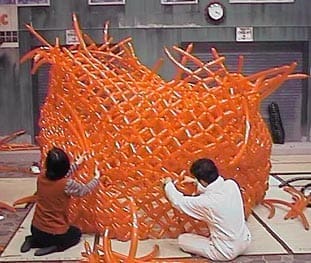 |
| Midsection of demon head |
Demon
The demon had to sharply contrast the samurai. We decided to make the face
of the demon completely inhuman in size. Since we were very careful about
the samurai’s proportions, we knew that an oversized demon face would stand
out against it. Anyone perusing the original sketches can see that this
was not part of the original plan, but with several stumbling blocks
overcome, we were able to make a single piece that stood 12 feet tall on
it’s own.
It doesn’t take a lot of close examination to see that we built the demon
head using a similar method to the samurai kimono. This allowed us to make
something very large and with a very nice texture without the time
necessary to make a lot of small bubbles. We also broke down the head into
three distinct sections that were then attached to each other.
The mid section of the head was simply a very wide cylinder. The top
portion was essentially a dish that got placed on top. Unfortunately, I
took a two hour rest during which the staff decided to help me and atach
that top portion. I wasn’t quite ready for that and it took some
interesting maneuvering to finish it all off once it was mounted on the
frame.
The hardest part of the head was assembling the lower portion. Since the
mid section and top were placed on the frame before the botom was
completed, the head was suspended in the air with a three foot gap
underneath it. We found the quickest and easiest approach to completing
the bottom portion was to work downward from
the lowest portion of the head until we hit the platform.
My original plans called for hair that was as full and rigid as the
samurai’s hair. Unfortunately, that wasn’t possible due to time
constraints. The simpler, faster, and still interesting look that we went
with was accomplished simply by shoving fully inflated balloons into the
spaces all over the top and back of the head.
The facial features were all made on the side while the head was being
constructed. Finishing off the demon
required some rather tall ladders and a number of hands.
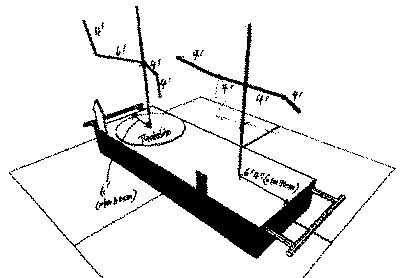 |
| The entire sculpture was built on this movable platform. |
The underlying structure, drawings, and special effects
As with any large scale creation involving multiple workers, a diagram of
the final structure can be a handy tool. Sadly, one of my greatest
weaknesses is the lack of any real drawing skill. My art is balloons. In
fact, I think of a balloon as a paintbrush. I find it much easier to
create with balloons than a pencil. When I do drawings of my smaller
sculptures as teaching tools for others, it’s only after I’ve already
twisted the figure. I then work with a figure in front of me as I put it
into two dimensional form.
I’ve never before worked with someone else in creating a huge balloon
sculpture. I’ve always done it myself. I often work with constraints in
mind, and as I sculpt, I shape things and modify my plan in order to make
it work and make it look as good as possible. However, I had up to two
dozen people working at once on this project. There was no way for me to
do it myself, even if that’s what I had been hired to do. What’s more, I
couldn’t coach each person individually through the whole thing. Had I
found a way to be in more than one place at time, there still would have
been the language barrier. Clearly drawings were essential.
To top it all off, I was asked to send drawings a couple weeks ahead of
time to make sure that my vision was the same as that of the television
people. With some drawings of traditional
nebuta sculptures to work from, I set out to draw my own. It was good that they asked
since my understanding of what they wanted wasn’t quite right. The hard
part was in showign them what I wanted to do. I would have greatly
preferred someone else giving me a drawing and telling me which things were
important and which things allowed for my creativity. Regardless, I got
through it.
Typically, I don’t work with framing materials, but there were several
reasons for using a framework of some sort
here. The frame wasn’t actually necessary in the end, which was my
preference, but the insurance it provided was well worth having.
Demon Head
Demon nose
various demon parts
Samurai hand
Samurai’s kimono
Samurai’s face
Samurai sword
lighting, frame assembly
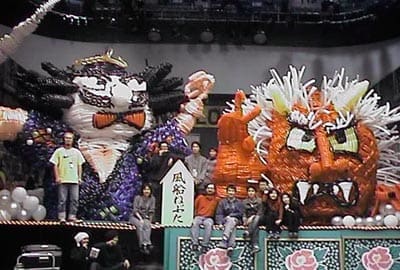 |
| The staff stands proudly by their creation one last time before it’s destroyed. |
Pictures of the whole thing
The Fuji TV building that this was all done in
Back of sculpture
Lots of work being done here
Parts is parts
The platform we’re building on
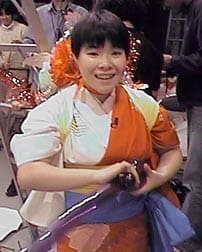 |
| This is the first time she smiled. |
Some of the people involved
Chris Suguira
The staff just getting familiar with balloons
Emily Suguira
Kiyomi Okuba – a very patient translator
One of the celebrities, smiling for the first time.
More of the staff
Celebrities
Celebrities
Celebrities
Celebrities
Celebrities
Celebrities
Celebrities
lighting, motion, lack of sleep.
All images found within this directory copyright 1998 by Larry Moss